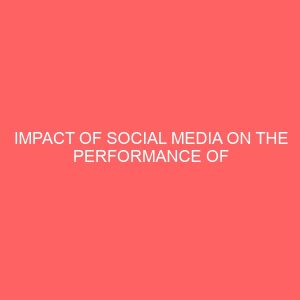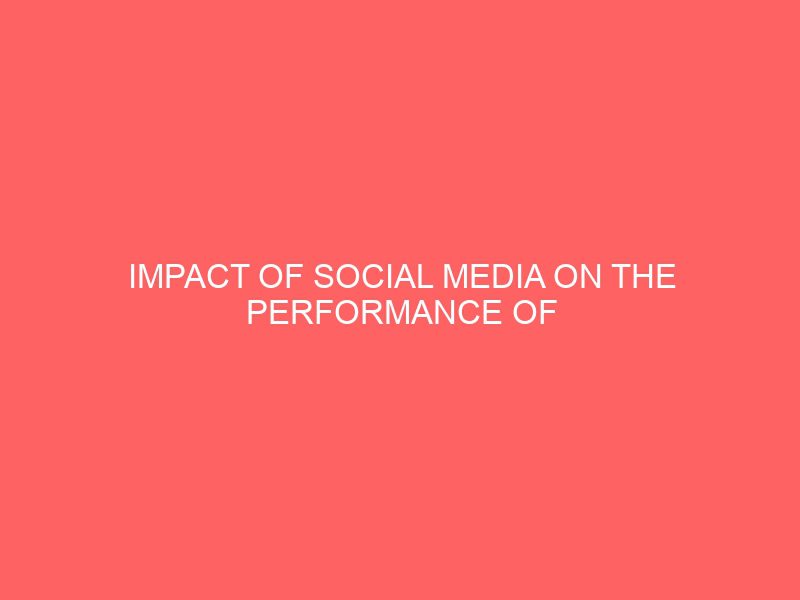Description
CHAPTER ONE
INTRODUCTION
1.1 BACKGROUND OF THE STUDY
Interacting with friends and family across long distances has been a concern of humans for centuries. As social animals, people have always relied on communication to strengthen their relationships. When face-to-face discussions are impossible or inconvenient, humans have dreamed up plenty of creative solutions.
The emergence of technology and advent of social media has come to be as its intent and useful use can help in aiding greatness in everyone’s life irrespective of gender, status and age. It helps to develop an individual and is also important when trying to pass an examination as materials to aid learning can be gotten online. The dwindling rate at which students read is questioned if it is been caused by the wrong usage of all forms of communication technology. Social media and its networks such as BBM, WHATSAPP, Instagram, 2go, Facebook, Twitter, Badoo, YouTube and the use of Internet as a whole has been the major obsessions of most Nigerian youths. Despite the fact that the social media is making student’s academics suffer, it also have some positive contributions to education. Social media is a method of communication. Social media use is popular among students. However excessive social media use raises questions about whether academic performance is affected. This research will explore this question by conducting survey on the students of The Ibarapa Polytechnic, Eruwa, Department of business administration in regard to social media usage and their academic performance.
It will also explore which social network is the most popular among them, thoughts of students about their social media usage and factors besides social media usage which negatively affect academic performance.
1.2 HISTORY OF SOCIAL MEDIA
Social Media Before 1900
The earliest methods of communicating across great distances used written correspondence delivered by hand from one person to another. In other words, letters. The earliest form of postal service dates back to 550 B.C.
In 1792, the telegraph was invented. This allowed messages to be delivered over a long distance far faster than a horse and rider could carry them. Although telegraph messages were short, they were a revolutionary way to convey news and information.
Although no longer popular outside of drive-through banking, the pneumatic post, developed in 1865, created another way for letters to be delivered quickly between recipients. A pneumatic post utilizes underground pressurized air tubes to carry capsules from one area to another.
Two important discoveries happened in the last decade of the 1800s: The telephone in 1890 and the radio in 1891.
Both technologies are still in use today, although the modern versions are much more sophisticated than their predecessors. Telephone lines and radio signals enabled people to communicate across great distances instantaneously, something that mankind had never experienced before.
Social Media in the 20th Century
Technology began to change very rapidly in the 20th Century. After the first super computers were created in the 1940s, scientists and engineers began to develop ways to create networks between those computers, and this would later lead to the birth of the Internet.
The earliest forms of the Internet, such as CompuServe, were developed in the 1960$. Primitive forms of email were also developed during this time. By the 70s, networking technology had improved, and 1979’s UseNet allowed users to communicate through a virtual newsletter.
By the 1980s, home computers were becoming more common and social media was becoming more sophisticated. Internet relay chats, or IRCs, were first used in 1988 and continued to be popular well into the 1990’s.
The first recognizable social media site, Six Degrees, was created in 1997. It enabled users to upload a profile and make friends with other users. In 1999, the first blogging sites became popular, creating a social media sensation that’s still popular today.
Social Media Today
After the invention of blogging, social media began to explode in popularity. Sites like MySpace and Linkedln gained prominence in the early 2000s, and sites like Photobucket and Flickr facilitated online photo sharing. YouTube came out in 2005, creating an entirely new way for people to communicate and share with each other across great distances.
By 2006, Facebook and Twitter both became available to users throughout the world. These sites remain some of the most popular social networks on the Internet. Other sites like Tumblr, Spotify, Foursquare and Pinterest began popping, up to fill specific social networking niches.
Today, there is a tremendous variety of social networking sites, and many of them can be linked to allow cross-posting. This creates an environment where users can reach the maximum number of people without sacrificing the intimacy of person-to-person communication. We can only speculate about what the future of social networking may look in the next decade or even 100 years from now, but it seems clear that it will exist in some form for as long as humans are alive.
1.3 STATEMENT OF RESEARCH PROBLEM
This research work is mainly interested with the impact of social media on the performance of students of tertiary institutions with a specific attention to the business administration students of The Ibarapa Polytechnic, Eruwa.
Due to the popularity of social media among students, considering the fact that virtually all students have one or more social media account with the added advantage of instant messaging, access to news reports as it breaks, ability to create interactive session for the readers aiding adequate feedback, availability of video, pictures, voice recording which most medium like Newspaper or Magazine Cannot satisfy, that is, the quest of a greater field of enlightenment by students.
This study will help in knowing the impact of social media and how it affects students performance. It will also explore which social network is the most popular among them, thoughts of students about their social media usage and factors besides social media usage which negatively affect academic performance.
1.4 PURPOSE OF STUDY
1. To carry out a research on student’s accessibility to social media.
2. To consider the popularity of social medium of communication, examining the population of students who operate account on any of the social media and the effect the medium has on them as students.
3. This study will also help to suggest reasonable hours to be used on social media per day which won’t affect students academic performance.
1.5 SIGNIFICANCE OF STUDY
This study will contribute to the knowledge of students on how social media has helped or affected their performance as students. It will also help students see the impact of social media on their academics and see ways of adjusting so as to better their grades. This research will help serve as a eye opener to lecturers and see how the social media can be fully utilised to help lecturing.
1.6 RESEARCH QUESTIONS
1. Do students have access to social media?
2. How many social media account do you operate?
3. How many hours do you use on social media per day?
4. What role has social media played in your academic performance?
5. Suggest number of hours reasonable to use on social media per day which won’t negatively affect student’s academic performance.
1.7 SCOPE OF THE STUDY
The research will be conducted among Students of The Ibarapa Polytechnic, Eruwa, Department of Business Administration.
1.8 OPERATIONAL DEFINITION OF TERMS
This research work will not be complete without the definition of some terms used in the course of writing the research on Impact of social media on the Performance of students of tertiary institutions.
1. Impact: A significant or strong influence; the powerful effect that something has on someone.
2. Social Media: Social media are computer-mediated technologies that facilitate the creation and sharing of information, ideas, career interests and other forms of expression via virtual communities and networks.
3. Performance: How well or badly something such as a piece of work, task or duty is done.
4. Tertiary Institutions: Tertiary education, also referred to as third stage, third level, and post-secondary education, is the educational level following the completion of a school providing a secondary education. The World Bank, for example, defines tertiary education as including universities as well as institutions that teach specific capacities of beer learning such as colleges, technical training institutes, community colleges, nursing schools, research laboratories, centers of excellence, and distance /earning centers. Higher education is taken to include undergraduate and postgraduate education, while vocational education and training beyond secondary education is known as further education in the United Kingdom, or continuing education in the United States.
Tertiary education generally culminates in the receipt of certificates, diplomas, or academic degrees.







